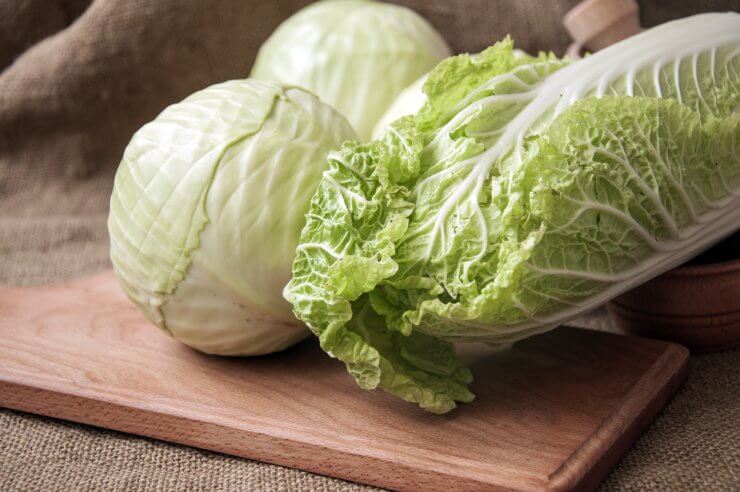
Cabbage is pretty easy to grow, especially if you live in a cooler climate. One only needs to think of a traditional Irish garden to understand how much cabbage you can grow if you live in areas with shorter summers and long temperate spells with high temperatures in the mid-60s. That means it’s entirely possible to harvest a LOT of cabbage, so you’ll need a few ways to preserve cabbage for later.
Don’t get me wrong, I love a coleslaw or cabbage stew, but there’s only so much cabbage you can eat in one sitting. Am I right? So let’s look at some different ways to preserve cabbage so you can enjoy that nutritious, delicious vegetable at some point in the future.
Discover 7 top tips for growing, harvesting, and enjoying tomatoes from your home garden—when you access the FREE guide The Best Way to Grow Tomatoes, right now!

5 Ways to preserve cabbage that are easier than you realize
1. Stick it in the fridge. Did you know you can store fresh cabbage in the refrigerator for about two weeks? You don’t have to rinse it, either. Just cover it loosely with a plastic bag and find a nice spot in your fridge for it.
2. Freeze it. Freezing is one of the easiest ways to preserve cabbage if you want longer-term storage. The National Center for Home Food Preservation offers these instructions:
- Trim the outer leaves from a freshly picked head of cabbage.
- Cut the cabbage into thin wedges or course shreds.
- Blanch for 90 seconds.
- Cool and drain, then package the cabbage, seal it, and place it in the freezer.
3. Dry it. Yes, you can dry cabbage. I’ll be honest, I haven’t tried it, but according to the University of California Master Food Preserver Program, it’s just a matter of removing the outer leaves and coring the cabbage, then blanching strips for 90 seconds. Then dry it in a dehydrator for 10-12 hours until brittle.
4. Can it. Wait! Canning is actually NOT one of the recommended ways to preserve cabbage. I’m including it because I think it’s a natural question, given that so many other vegetables are amenable to caning. However, the National Center for Home Food Preservation and the Michigan State Extension program agree that canning cabbage results in “discolorations and strong flavor,” and who am I to argue with them? There’s no good reason to ignore food safety protocols and suggestions, so skip the idea of canning cabbage.
5. Ferment it! This is a two-for-one special and my two favorite ways to preserve cabbage. Make Kimchi or Sauerkraut with your garden-fresh cabbage. Kimchi is a traditional Korean side dish or condiment made of cabbage (usually Napa cabbage), green onions, radishes, Korean red peppers, and garlic. Of course, like many traditional dishes all over the world, you can find countless variations based on season, location, history, and so on.
Sauerkraut is another fermented cabbage dish, though the process takes around six weeks instead of just a few days for kimchi. The ingredient list is much smaller, though. You just need cabbage and salt.
Of course, if none of these feel like the right choice, you can always make a big batch of Worth the Wait Cabbage Soup and freeze whatever you don’t eat. Whatever you decide, don’t let your abundance of cabbage overwhelm you. You have choices!
What is your favorite preservation method for cabbage? Share your ideas in the comments!
Discover 7 top tips for growing, harvesting, and enjoying tomatoes from your home garden—when you access the FREE guide The Best Way to Grow Tomatoes, right now!





You can preserve cabbage by burying them, my dad would dig a hole line it with straw and put the cabbages in cover them with straw and then cover with dirt, the cabbage will last for the winter
We freeze the cabbage in wedges by vacuum seal bags.Our favourite way of storing cabbage is by making saurkraut and kimchi-love the stuff.
I use the cabbage in the bag method. My cabbage is store bought, not fresh picked, I have left the cabbage in the frig. for as long as 2 month and only lost about 2 layers of leaves. JP
We were taught in microbiology, (by a microbiologist), that food molds from the inside out. We also learned that often times, you can see mold or soft spots in foods on the outside before the inside. We were instructed to throw away any foods with any mold anywhere. Here lately, I’ve pulled off cabbage leaves that had black spots & used it anyway. We didn’t get sick. It would be important to discard it if someone had an allergy to mold thought to be on the safe side.